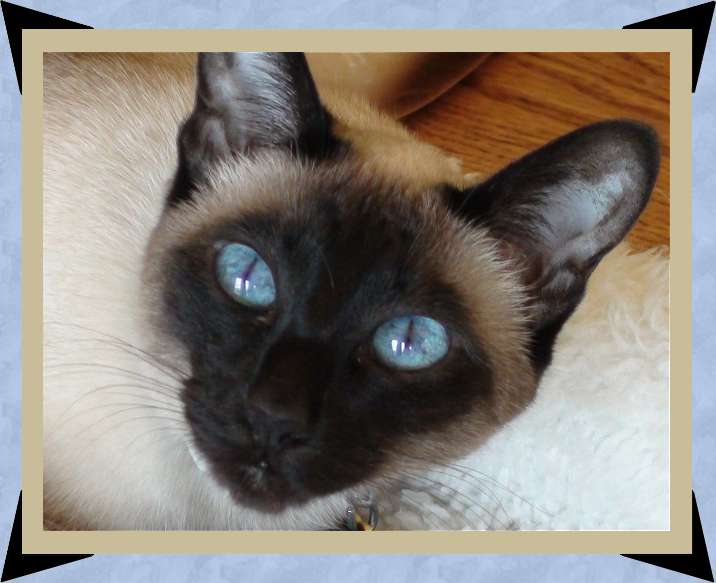
~ This page is supplemental information about Maeve's death. ~

Maeve Guinness of Black &Tan
8/18/2004 - 6/18/2011
|
Maeve died on 6/22/2011 of renal failure. Her kidney damage was not of genetic or congenital origin.
In 2007 when the massive pet food recall happened. Maeve was eating the Iams Chicken Select Bites in Gravy packets that were melamine tainted. She also had her Royal Canin food but we were spoiling her with the Iams as treats. She was our only cat eating the Iams. We were trying to get her weight back up after the bad septic infection she had with her last litter in the fall of 2006. When we learned of the recall, we immediately took her to the Cat Hospital. They ran a kidney profile and her function was on the low side of normal. Dr. Duckett told us there was nothing to do for her as she was not symptomatic. He also told us we would not know how much damage was done until she turned 6 years of age because cats only use 1/3 of their kidneys. They have to lose function of 2/3's before they show symptoms. Natural aging changes begin to show after the age of six. Kidney crystals are microscopic and cannot be seen in an ultrsound. Pet food that had meat chunks in gravy were at the center of the recall. The melamine was mixed with the wheat gluten that helps the chunks hold their shape.
In Dec 2007-Jan 2008 Maeve had a serious pyrometra infection and was hospitalized for a week at Tuft's University small animal hospital. This infection also went into her kidneys. She had multiple ultrasounds of her kidneys at the time. There were no congenital abnormalities and no evidence of a genetic kidney disease. The doctors at Tufts were worried she would become a CRF cat if they could not get the infection out of her kidneys. She did well and came home infection free and with her kidney function on the low side of normal. I was very worried that possible scaring from her infections combined with the melamine damage would cause her to present with symptoms sooner then later. Maeve turned 6 in 2009 and was fine, she turned 7 in 2010 and was still fine. I began to hope she had not ingested enough melamine to hurt her but I knew that one day she would present with kidney failure symptoms. This spring 2011 Maeve became thin again. While we were away our pet sitter emailed to let us know she thought Maeve had thrown up once. Well cats do that from time to time so I didn't think much of it. When we returned home a few days later I was shocked at how thin Maeve looked. I told myself maybe she didn't eat because we had left her. If your a Siamese owner you know how some Siamese are. I watched her closely. She was eating well for me and not throwing up at all. It wasn't long before I knew Maeve was in acute kidney failure. She was dehydrated and begging for water in the bathroom but wouldn't drink out of a cup or bowl. Not a normal behavior for her. We had a kidney panel done, the results were terrible. Her BUN was126 normal range is 15-34. My vet expected her to die any day. She assured me that kidney failure is not a painful condition. She said cats feel like people who are on dialyses feel. They have good days and bad days but they are not in pain. We began sub-q fluids with the hopes her high results would be at least cut in half. She received an antibiotic shot just in case she had another kidney infection. We re-tested her after a week and the values had not changed. Her BUN was 129. Maeve continued to function at a pretty good level while receiving the sub-q fluids. We tried cutting back the frequency but for most of the time she was receiving them daily. She never ate enough even though she was hungry and wanted food. We added a prescription (phosphorus binder) powder to her food. We bought every wet food on the market but she continued to get thinner. She was present and had many more good days then bad. She didn't seem to be suffering. I discussed with my vet the melamine and what we had been told. I learned from her there are two oppositional opinions in the Veterinary community on the melamine and its effects in the long term. I did not and have no intention of pursuing this as a claim with the food company. I don't think the pet food companies did this on purpose. I think they were victims just as we were. I've done internet searches through the years on the effects of the melamine tainted food. I've read a number of studies and reports on the crystal formations in the kidneys of animals that died from it. I fully expected to learn that crystals were the cause of Maeve's kidney failure. My Vet informed me that if a cat ate the melamine tainted food and died at that time of ingestion the crystals were seen in the kidneys. If the cat did not die the crystals dissolve over time and leave the damage they caused, scaring or lesions as the pathologist calls them. If they were treated at the time of ingestion and the kidneys were flushed out the kidneys could heal some over time. She has some older dogs in her practice that are doing very well after treatment. Keep in mind that a cats kidneys are four times more sensitive to toxins. We did have a necropsy done. |
| June 29th, 2011 - I have the pathology report, from a local lab, on Maeve's kidneys in front of me and I'm at a loss for words. |
|
WHAT? I don't understand how Maeve could have been poisoned by anti freeze. Maeve is an inside only cat. We don't have anti freeze in the house. We don't have any plants in the house that have ethylene glycol in them. We don't have any anti freeze in the garage...except in the cars radiators. No puddles on the cement floor. What would be the source? None of our other cats are sick. How little anti freeze is needed to kill a cat? Would dried up anti freeze from a parking lot on the bottom of shoes have been enough? ASPCA says the minimum to cause death is 1.4 ml/kg in cats. 1.4ml is a little more then a quarter of a teaspoon and 1kg is about 2.2lbs. Multiply these numbers to equal the weight of the animal. I filled a teaspoon with water and dumped it on the counter. I think we would have noticed that much antifreeze. Maeve lived for more almost 4 months after her symptoms were observed. I had the impression that death from anti freeze poisoning came very quickly? This document Clinical Pathology of Ethylene Glycol Toxicosis from www.vet.uga.edu states it takes only 72 hours for a cat to go through all the stages after ingesting the poison. A friend who's sister and brother in law are veterinarians tells me the pathology of these two poisons (melamine & ethylene glycol) is very similar. When Maeve first became symptomatic I did a search on melamine toxicity and found a report from a vet who had a cat that ate the tainted food and recently died. He found crystals in the kidneys. He published his findings as a way to show that it is still out there killing pets. I wish I had saved the link. I can't find it now that I want to add it to this page. In this article, Melamine hangover lingers over pet food industry, on the Veterinary Information Network from Oct 2009 A University of Melbourne-trained veterinarian with expertise in emergency medicine, Dr. Thorley, practicing in Hong Kong noticed an increase in acute renal failure cases. He wrote, "One renal biopsy result came back that the kidneys had been damaged by 'unusual' crystal deposition causing renal failure. The histopathologist wasn't sure what the crystals were. He thought they might have been ethylene glycol (antifreeze), which is surely impossible in subtropical Hong Kong." please note this is a quote from his published work. In this PDF presentation Melamine Toxicosis - A Clinical Pathologists view
Fred Reyers Registered Veterinary Pathologist: Clinical Pathology Says
"Were told it was Ethylene glycol I have this report in front of me but I find myself questioning the results. I am bothered by the wording. The crystal formation is intriguing? Not standard for ethylene glycol poisoning? The veterinary school at Washington State University estimates that as many as 10,000 dogs and cats ingest antifreeze each year. The "crystals present a distinct possibility"? Not a certainty from their distinct shape? Ethylene glycol toxicity is one of the two the most common causes of acute renal failure (ARF) in small animals. You're not certain what it looks like? With the aid of the internet I know this pathologist is 65 years old. He should have lots of experience. The results of this report bothered me so much that I asked my vet about getting a second opinion. We sent the biopsy to Cornell University Animal Health Diagnostic Center. They used the same slides that first lab used. Cornell's research center is responsible for the changes in vaccination protocols from every year to every three years. They have a large leading edge facility. We know Maeve died of an ingested toxin the question I have is which one? We consider ourselves informed, involved and conscientious cat owners. We want to prevent any future poisonings in our cats. Knowing what the poison was will help us to prevent future contact with that toxic substance. This is important enough pay twice to verify these results. We don't use chemical poisons in our home. Our floors are washed with vinegar & water and I use a 1/10 solution of bleach & water, spray for sterilizing surfaces when needed. |
| July 6th, 2011 - I received the Anatomic Pathology from the Department of Biomedical Sciences at Cornell. |
|
The Cornell report states:
I discussed this report with Dr. Schaefer. She told me she spoke to three pathologist about Maeve's results. Because the crystals are no longer present they cannot say that the melamine was the definitive cause of the damage to her kidneys. I was told that all of the pathologists couldn't understand why I wanted know? They all had to be reassured that I was not going to enter into a lawsuit. No one is eager to put anything into writing regarding the melamine. It is Dr. Schaefer's opinion that this report from Cornell indicates that Maeve's kidney failure was not a genetic disease. It supports that Maeve's kidney damage was from eating melamine tainted food and scaring from her kidney infection. |
All images, text, and all other contents of this site are protected by copyright law.
The contents of this site may not be reproduced, distributed, exhibited, published, or used in any form, in whole or in part, without prior written permission from the
copyright holder.
All images, and text copyright © Black&Tan, 2011-2013| All Rights Reserved | Contact